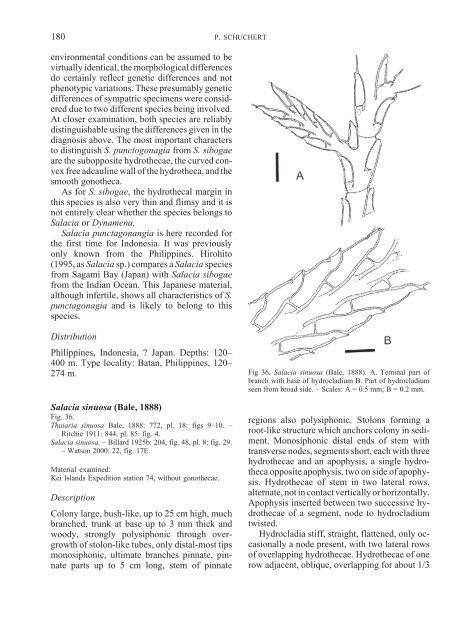Hydroids (Cnidaria, Hydrozoa) of the Danish expedition to
Hydroids (Cnidaria, Hydrozoa) of the Danish expedition to
Hydroids (Cnidaria, Hydrozoa) of the Danish expedition to
Create successful ePaper yourself
Turn your PDF publications into a flip-book with our unique Google optimized e-Paper software.
180<br />
environmental conditions can be assumed <strong>to</strong> be<br />
virtually identical, <strong>the</strong> morphological differences<br />
do certainly reflect genetic differences and not<br />
phenotypic variations. These presumably genetic<br />
differences <strong>of</strong> sympatric specimens were considered<br />
due <strong>to</strong> two different species being involved.<br />
At closer examination, both species are reliably<br />
distinguishable using <strong>the</strong> differences given in <strong>the</strong><br />
diagnosis above. The most important characters<br />
<strong>to</strong> distinguish S. punc<strong>to</strong>gonagia from S. sibogae<br />
are <strong>the</strong> subopposite hydro<strong>the</strong>cae, <strong>the</strong> curved convex<br />
free adcauline wall <strong>of</strong> <strong>the</strong> hydro<strong>the</strong>ca, and <strong>the</strong><br />
smooth gono<strong>the</strong>ca.<br />
As for S. sibogae, <strong>the</strong> hydro<strong>the</strong>cal margin in<br />
this species is also very thin and flimsy and it is<br />
not entirely clear whe<strong>the</strong>r <strong>the</strong> species belongs <strong>to</strong><br />
Salacia or Dynamena.<br />
Salacia punctagonangia is here recorded for<br />
<strong>the</strong> first time for Indonesia. It was previously<br />
only known from <strong>the</strong> Philippines. Hirohi<strong>to</strong><br />
(1995, as Salacia sp.) compares a Salacia species<br />
from Sagami Bay (Japan) with Salacia sibogae<br />
from <strong>the</strong> Indian Ocean. This Japanese material,<br />
although infertile, shows all characteristics <strong>of</strong> S.<br />
punctagonagia and is likely <strong>to</strong> belong <strong>to</strong> this<br />
species.<br />
Distribution<br />
Philippines, Indonesia, ? Japan. Depths: 120–<br />
400 m. Type locality: Batan, Philippines, 120–<br />
274 m.<br />
Salacia sinuosa (Bale, 1888)<br />
Fig. 36.<br />
Thuiaria sinuosa Bale, 1888: 772, pl. 18: figs 9–10. –<br />
Ritchie 1911: 844, pl. 85: fig. 4.<br />
Salacia sinuosa. – Billard 1925b: 204, fig. 48, pl. 8: fig. 29.<br />
– Watson 2000: 22, fig. 17E.<br />
Material examined:<br />
Kei Islands Expedition station 74, without gono<strong>the</strong>cae.<br />
Description<br />
Colony large, bush-like, up <strong>to</strong> 25 cm high, much<br />
branched, trunk at base up <strong>to</strong> 3 mm thick and<br />
woody, strongly polysiphonic through overgrowth<br />
<strong>of</strong> s<strong>to</strong>lon-like tubes, only distal-most tips<br />
monosiphonic, ultimate branches pinnate, pinnate<br />
parts up <strong>to</strong> 5 cm long, stem <strong>of</strong> pinnate<br />
P. SCHUCHERT<br />
Fig 36. Salacia sinuosa (Bale, 1888). A. Teminal part <strong>of</strong><br />
branch with base <strong>of</strong> hydrocladium B. Part <strong>of</strong> hydrocladium<br />
seen from broad side. – Scales: A = 0.5 mm; B = 0.2 mm.<br />
regions also polysiphonic. S<strong>to</strong>lons forming a<br />
root-like structure which anchors colony in sediment.<br />
Monosiphonic distal ends <strong>of</strong> stem with<br />
transverse nodes, segments short, each with three<br />
hydro<strong>the</strong>cae and an apophysis, a single hydro<strong>the</strong>ca<br />
opposite apophysis, two on side <strong>of</strong> apophysis.<br />
Hydro<strong>the</strong>cae <strong>of</strong> stem in two lateral rows,<br />
alternate, not in contact vertically or horizontally.<br />
Apophysis inserted between two successive hydro<strong>the</strong>cae<br />
<strong>of</strong> a segment, node <strong>to</strong> hydrocladium<br />
twisted.<br />
Hydrocladia stiff, straight, flattened, only occasionally<br />
a node present, with two lateral rows<br />
<strong>of</strong> overlapping hydro<strong>the</strong>cae. Hydro<strong>the</strong>cae <strong>of</strong> one<br />
row adjacent, oblique, overlapping for about 1/3

















